
SUZUKI Swift 5 Doors
Generations Timeline, Specs and Pictures
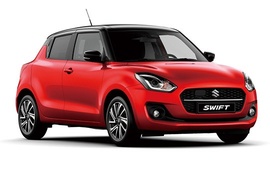
Suzuki was known as a great manufacturer for small cars and Swift was one of their main products that came to support that statement.
In 2020, the Swift was revived with a facelift.
In 2017, Suzuki introduced the fourth generation of its super-mini range, the Swift. It offered a new design and new technologies, that made it go further and be trusted on the market. By 2020, some of the technical solutions needed to be replaced, and the facelift version fixed that.
On the outside, the design remained almost unchanged, but there were few details that made the 2021 model look different. For starters, there was a new mesh for the grille instead of the former horizontal slats. The headlights were slightly redesigned. There were slight modifications to the rear of the car.
Inside, the first modifications were made to the instrument cluster. The dials were slightly different. In the tachometer, the coolant temperature gauge was now circular instead of a quarter circle as before and the same went with the fuel level gauge installed inside the speedometer dial. For the 2021 model, the button for the lane-keep assist was placed on the right side of the steering wheel, in the lower spoke.
Under the hood, the Swift went through important modifications with the introduction of the mild-hybrid systems. A 1.2-liter engine offered 83 hp and was built for a better fuel-efficiency. It was fitted with an Integrated Starter Generator (ISG) as well. The 1.2-liter unit was available with a CVT transmission for the front-wheel-drive versions. In some markets, the 2021 model was offered with an all-wheel-drive system.
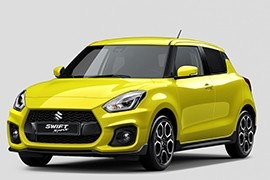
One of the cheapest hot hatches, the Suzuki Swift Sport was released in 2017 at the Frankfurt Motor Show, reaching its 3rd generation.
The exterior was redesigned with a wider and lower stance and the small Swift got a more aggressive styling. At the rear, the Swift got a new diffuser look.
The Swift Sport was built on the new Suzuki platform that increased the overall performance through with being light weight and highly rigid. The wheelbase was with 20 mm longer.
Compared to its predecessor, the new Swift’s rigidity was improved by 1.4 times. The rear suspension was improved for 2017 and offered great stability even at higher speeds.
Inside the cabin, the plastics used weren’t great, but the colored interior accents compensated with a nice look. New gauges that indicated boost and oil temperature enhanced the sporty experience.
The new Swift featured a Bluetooth connectivity, as well as a 7-inch touchscreen display with an SD Card 3D map navigation.
Safety wasn’t ignored this time either, with the new package including advanced forward detection, a dual sensor brake support system and lane departure warning.
A 1.4-liter boosterjet engine was mounted on the Swift Sport and it delved 230 Nm of torque. While it delivered high power, the fuel consumption remained decent.
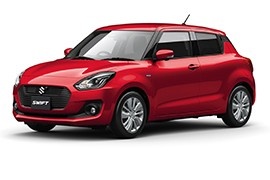
Starting with the third generation of the Swift, Suzuki deleted the three-door version and offered only the five-door model.
Suzuki had a respectable experience in building small vehicles, and it proved that many times. The Swift was its best-known product in the city-segment, and it tried to make it even better. For the 2017 model, it didn’t care that much about a budget-priced vehicle. It tried to make the car better and hoped that the customers would love the car—worth saying that the market fulfilled its expectations.
The Swift’s styling followed the same proportions as its predecessor, but with rounded lines and even softer edges. At the front, the big mesh-grille filled the space between the hood and the lower spoiler. On the sides, the swept-back headlights with LED daytime running lights showed a similar shape as those installed on Swift’s third generation. The carmaker tried to make the hatchback look like a three-door vehicle while it installed five doors from its sides. Suzuki masked Swift’s rear doors’ handles into a black area on the C-pillar.
Inside, the Japanese carmaker kept its promise to offer a roomy cabin fit for four. There was room for three in the back, especially if they were kids or teenagers. At the front, Suzuki worked hard to offer a much better and functional design. A silver panel divided the dashboard into two distinct areas, with the upper side reserved for ventilation and instrument panel, while the lower one was designed for storage compartments and the center stack. Suzuki offered, as an option, depending on the trim level, an infotainment system.
Suzuki removed the 1.3-liter diesel engine from the Swift’s lineup and kept only gasoline, or mild-hybrid engines paired to either a manual or a CVT transmission with front- or all-wheel-drive.
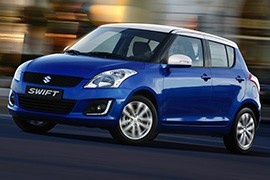
Suzuki introduced the third generation for the Swift in 2010, and four years later, it introduced a facelift for the European version, for both three- and five-door versions.
The Swift was one of the most important models for the Japanese carmaker Suzuki. It was designed for urban traffic and managed to achieve great fuel efficiency. Despite its small sizes, the little vehicle built by Suzuki in Hungary managed to offer a good interior room.
While the vehicle was not considered “old” by any standards, Suzuki tried to make a few changes to comply with future European regulations regarding safety and emissions. Thus, the facelifted model featured LED daytime running lights installed in the lower bumper area and slightly redesigned headlights. For someone, it was almost impossible to distinguish the pre- and post-facelifted version from behind.
Inside, the carmaker didn’t consider that there will be needed any changes and, apart from a few minor changes on the trim levels, it remained the same vehicle as before. It kept the split-folding rear bench and the high seating position for all the occupants.
Under the hood, the carmaker introduced a Fiat-sourced turbo-diesel engine. It paired it to a 5-speed manual transmission, and the final result was a very fuel-efficiency vehicle. For selected markets, Suzuki offered the Swift with an all-wheel-drive system.
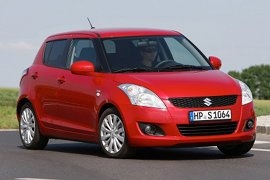
Suzuki was one of the biggest carmakers of small vehicles, and the Swift confirmed the carmaker’s intentions to own the segment.
After ending its agreement with Opel for the Agila/Wagon R duo, Suzuki remained with a factory in Hungary where it built the European version of the Swift with three and five doors. Its small-segment vehicle simple design from the previous generation evolved a bit, but it wasn’t that complicated either.
The short front side of the car with a rounded hood and curved triangular headlights were part of a sporty image. To keep the car short, the A-pillars were not too raked to the rear. A straight roof and a sharp drop in the back completed the image. Unlike its 3-door sibling, the five-door version featured shorter front doors and a split window on the rear doors.
Inside, the Swift featured high-mounted seats, and that led to a better leg and knee room for the rear passengers. It didn’t feature some fancy options. It offered a decent climate control system, an infotainment unit on the center console, and a Japanese-style instrument cluster. A small trunk was offered, and it was enough for the weekly shopping. The rear split-folding bench was handy when needed to transport anything bigger than a sandwich since the trunk was tiny, with the rear seats in an upright position.
Under the hood, the 3-door Swift was offered with just two engine choices: a 1.2-liter and a 1.3-liter turbodiesel carried over from Fiat. The gasoline version was available with an automatic transmission.

Suzuki started a new chapter with the 2005 Swift and designed it as a sporty, city-segment hot-hatch even though it didn’t offer any thrilling performances in the five-door version.
For some markets, the 2005 Swift was the first of its kind, but the Japanese carmaker built a few generations before it, either in Hungary or in Japan. In the U.S., those generations were mostly known as Geo Metro or Pontiac Firefly. Maybe they were not perfect or desirable, but they surely existed and cannot be ignored. But the 2005 model was a major step forward for Suzuki, and it changed the city segment.
With its rounded shapes and vertical, swept-back headlights, the Swift stood apart from its competitors due to its high greenhouse and tall door panels. Its blacked A- and B-pillars made the car looked like it had a floating roof. Its 3.7m (12.14 ft) length qualified it as a city vehicle, while its 2.4m (7.8 ft) wheelbase was just 10 cm (4”) shy of a Golf MK4’s. In the rear, the designers installed the taillights on the rear quarter-panels, which looked like shoulders.
Inside, Suzuki used its kei-car experience and installed tall seats that led to plenty of legroom for both front and rear passengers. Even though it was often criticized for the driving position, a big part of its customers were happy since they were shorter and could see from a bigger height than on most of the other city-segment vehicles.
Under the hood, Suzuki offered a choice of three engines. The 1.3-liter turbo-diesel version was carried over from Fiat. While most of the vehicles sported a front-wheel-drive configuration, Suzuki provided an all-wheel-drive system for specific markets.

Suzuki introduced a facelifted version for the Swift range in 1996, and the five-door hatchback was adapted to the European regulations.
With an increasing demand on the European market, Suzuki worked on the 1991 model to make it better for its new customers, especially since it built it in its Hungary factory. The small-segment vehicle was still one of the most affordable vehicles in its segment, and despite its price, it offered good comfort features.
The base trim levels still kept the black, unpainted, plastic bumpers, and the Japanese carmaker improved them for the upper versions. They sported a new grille at the bottom, which looked like an air-intake for a sports car, for the full-options version. Starting with the middle trim level, the Swift sported body-colored bumpers, and that led to a better image for the little Japanese car.
Inside, most of the parts were carried over from the 1991 model-year. Since it started to use more European suppliers, the materials fulfilled their new customers’ tastes. The dashboard was slightly upgraded and included new materials. To provide better comfort, Suzuki offered air-conditioning on the options list plus four power-windows.
Under the hood, Suzuki kept the same engines as before but upgraded to Euro 2 emission standards, which were mandatory starting with January 1997. Also, the 1996 Swift received an option for ABS and even an automatic transmission.
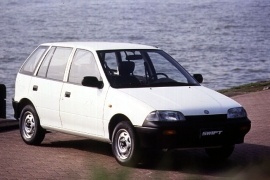
Suzuki introduced the second generation of the Cultus on the market in 1988 and, for specific markets, it rebadge-it as Swift and sold it in a few versions and under different brands.
The Japanese carmaker built this car for several markets under different badges and nameplates. While the Americans got the Geo Metro, the Australians had the Holden Barina and the Europeans received the Suzuki Swift. It was available in a few shapes and sizes, and the five-door hatchback was the one available everywhere. In 1991, Suzuki upgraded the engines and made them according to the Euro 2 emission standards.
With its modest design, the Swift managed to be an affordable, fuel-efficient vehicle. Its design was simple, with rounded panels and shaved edges. At the front, it featured a black, plastic wrapped-around bumper and a pair of horizontal headlights with corner-mounted turn-signals. Its narrow grille was just enough for the small engines installed under the hood. Its profile showed the three tall side windows related to the car’s height. It sported black mirror caps and door handles. The slightly curved, vertical tailgate ended above the taillights, making loading and unloading difficult.
Inside, it showed low-mounted slim seats at the front. Its new dashboard design was simple, flat, with a raised area for the instrument cluster. On the center stack, depending on the options, it was available with air-conditioning and a stereo-cassette. The narrow center console hosted the gear-stick and the hand-brake.
Under the hood, Suzuki installed a choice of two gasoline engines paired to a five-speed manual. For specific markets, it offered a four-speed automatic transmission.























































